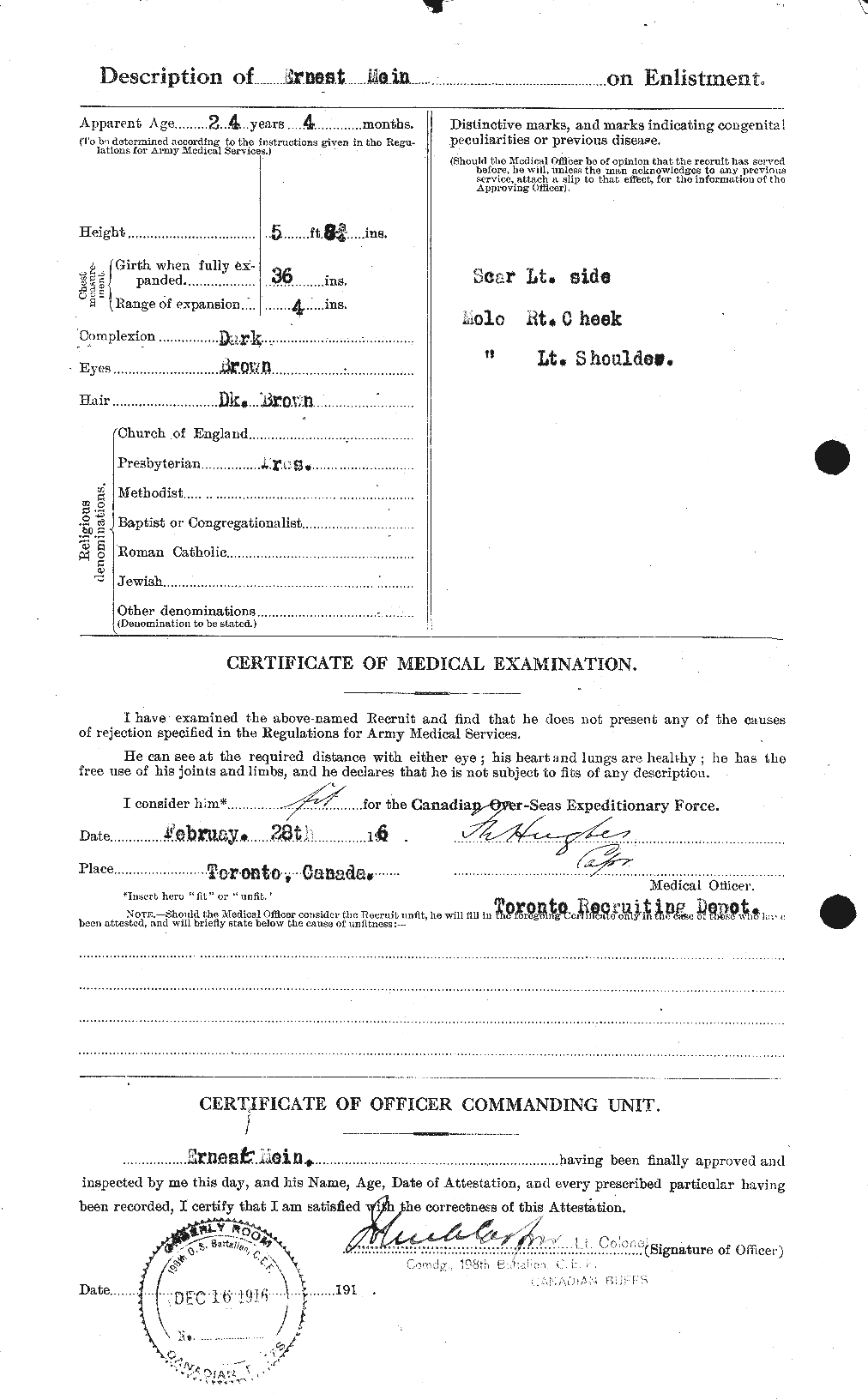Ernest Mein

1891-1918
Biography
Private Ernest Mein, reg # 916147 was born on October 9, 1891, in Peterborough, Ontario. He is the son of Robert and Jessie Mein, of 538, Harvey st, Peterborough. Ernest had one sister, Mrs. W.H Long, of Toronto. Before he enlisted he was a druggist which means he prepared drugs according to medical prescriptions. He had a scar on the left side of his body, a mole on his left cheek and shoulder. He had a dark complexion, dark brown hair, and brown eyes. Ernest was five feet, eight and three quarters of an inch. He was religious and attended the Parkdale Presbyterian Church, he is also a part of the Parkdale Canoe Club.
His Mother and Father moved houses while Ernest was at war, they moved to 19 Edna Ave in Toronto.
Ernest was enlisted in Toronto where he agreed to serve for one year and six months, in the 198th battalion in 1916. He was later transferred to the 2nd Canadian Mounted Rifles. Ernest was awarded a badge, a G.C strip on March 1st 1918. Ernest landed in france on march 8th 1918 and was at war. On August 26th 1918, the 2nd Canadian Mounted Rifles was going to attack their enemies position on the right between Arras and Cambrai, that's when Ernest was wounded. He was taken to England on september 1st. He was again wounded on the 4th of September. In his medical papers it states that he was seriously ill on september 12th. On the 7th of October he was taken off strength and was taken to the Weston Favell Hospital in Northampton England. While in the hospital Ernest developed Bronchitis and parabaligia. On October 9th Ernest Mein died from bronchitis and paraplegia. He is now buried in Northampton (Towcester Road) Cemetery ; Northamptonshire, United Kingdom.
The 198th Battalion


The 198th Battalion, CEF was a unit in the Canadian Expeditionary Force during the First World War. This was based in Toronto, Ontario and began recruiting during the winter of 1915/16. After sailing to England in March 1917, the battalion was turned into the 3rd Reserve Battalion on March 9, 1918.
2nd Canadian Mounted Rifles
The 2nd Canadian Mounted Rifles Battalion, (known as the 2nd Battalion, or simply 2 CMR) was authorized on 7 November 1914 as the 2nd Regiment, Canadian Mounted Rifles, CEF. The Battalion recruited in Victoria and Vernon, British Columbia and was mobilized in Victoria.
538 Harvey St, Peterborough
Wounded Soldiers
The Wounded men would be moved to a location where treatment for their injury would take place. Many hospitals were set up in various available buildings. Usually Casualty Clearing Stations (CCS) were set in tents. Anything serious such as amputation surgery was often performed at the CCS. Wounds that were very severe would normally become amputations. As traumatic as it was, amputation was able to save many men. In fact the surgery was preventing any infection. infection is a very serious complication for the wounded. For amputation, Doctors used the practice of ‘debridement’ which is the removal of damaged tissue or foreign objects from a wound. Carbolic lotion was used to wash wounds, which were then wrapped in gauze soaked in the lotion. Other wounds had bismuth iodoform paraffin paste smeared over severe wounds to prevent infection. Doctors were told to be very cautious in cases of malingering which means to exaggerate or feign illness in order to escape duty or work. That's what soldiers tried to do, they often tried to injure themselves or pretend to be ill just so that they didn't have to fight. It was very suspicious to the medical profession that wounds on the left side were made from the soldier themself.
This short clip is about wounded soldiers in the hospital during World War One. A former nurse shares her story about a soldier that she was treating.



Ernest's grave stone
NORTHAMPTON (TOWCESTER ROAD) CEMETERY
There are more than 170,000 war graves in the United Kingdom, many being those of servicemen and women killed on active service, or, because of sickness or disease. The graves, will be found in more than 12,000 cemeteries and churchyards. Northampton (Towcester Road) Cemetery contains 116 First World War burials and 17 from the Second World War, most of which form a combined war graves plot to the left of the chapel.

Ernest's Letters
Please Note: The following images are fictional letters and were not written by Ernest Mein.



Private Ernest Mein's Attestation Paper

Private Ernest Mein's Medical Examination

←
